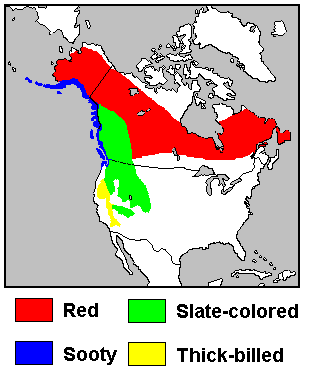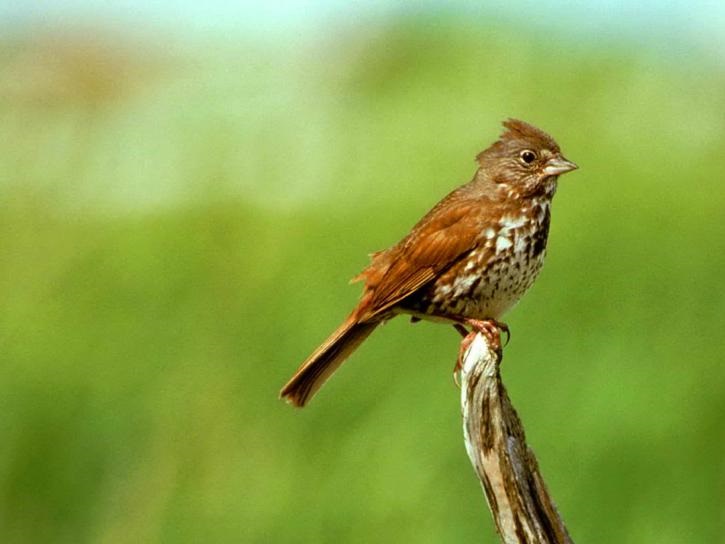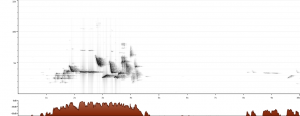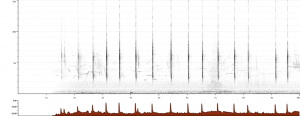Description
![By Factumquintus [<a href="https://creativecommons.org/licenses/by-sa/3.0/">CC BY-SA 3.0</a>], <a href="https://commons.wikimedia.org/wiki/Passerella_iliaca#/media/File:Passerella_iliaca-001.jpg">via Wikimedia Commons</a>](http://blogs.evergreen.edu/birds/files/2019/02/320px-Passerella_iliaca-001-300x220.jpg)
Red Fox Sparrow (P. iliaca), Whitby, Ontario
The Fox Sparrow (
Passerella iliaca) is a large sparrow ranging from 15.0–18.5 cm long, typically weighing between 25–49 g mass (Rising, 1996). It is the only member of the genus
Passerella, but is an extremely diverse species with 18 subspecies that are divided into 4 distinct groups which are considered by some authors to be distinct species (Zink, 2003). These groups have been divided based on dominate physiological traits. They include the red (
iliaca group), sooty (
unalaschcensis group), slate-colored (
schistacea group), and thick-billed (
megarhyncha group). Although there is extensive variation within the species, generally they have a sooty brown to slate colored crown that extends down past the back to the rump, and are sometimes found to have rufous colored streaking along the back. The wings and upper tail coverts along with the rectrices are generally dark sooty brown to rufous with variations of dark brown or black tipped primaries. The breast and flanks are sooty brown to rufous and typically have central white spots and/or streaks that extend down to the white belly. They often have a dark streak through their eye just under the sooty to slate colored supercilium and lore (Sibley,2016). They have a bicolored bill, with a dark gray upper mandible that gradually lightens at the margins, and a yellowish orange to gray lower mandible, size and coloration varies depending on the subspecies. Feet and legs are light brown with pink to red tones, and have an anisodactyl toe configuration (Nupen, 2016).
AllAboutBirds ID Images of each group.
Distribution
The Fox Sparrow is native to the North American continent and is widely distributed throughout Canada and the United States. Each sub group of the Passerella iliaca species has their own breeding and winter migration location preferences.
Red Fox Sparrow (P. i. iliaca) have a wide breeding range that is distributed throughout the taiga regions of northern and central Alaska, through northern and central Canada, all the way to Newfoundland. During the winter months, they are commonly found in the northeastern regions of the United States and can be found as far south as northeastern Central America. A recent study using eBird showed that some populations of the iliaca group have recently been observed breeding in some northern U.S. states, potentially due to the increased amount of young conifer forests (Lloyd, 2018).
Sooty Fox Sparrow (P. i. unalaschcensis) is sometimes referred to as the Pacific Fox Sparrow. This group has a fairly narrow breeding range that reaches from the far western islands of Alaska, all  the way along the southwestern coast of Alaska, to the western coast of British Columbia, ending around Vancouver Island, B.C. During the winter months they can be commonly found all along the Pacific coast of the United States as far south as Baja California, and as far east at the Cascade mountain range. They are typically considered to be a migratory species, but recent observations have reported that some populations are beginning to transition into permanent residents of British Columbia (Visty, 2018).
the way along the southwestern coast of Alaska, to the western coast of British Columbia, ending around Vancouver Island, B.C. During the winter months they can be commonly found all along the Pacific coast of the United States as far south as Baja California, and as far east at the Cascade mountain range. They are typically considered to be a migratory species, but recent observations have reported that some populations are beginning to transition into permanent residents of British Columbia (Visty, 2018).
Slate-colored Fox Sparrow (P. i. schistacea) have a breeding range that stretches from the northern interior of British Columbia all the way down to the interior of western central United States, between the Cascade and Rocky mountain range. This group spends the winter months in eastern California through Arizona and New Mexico, and as far south as Baja California. They can be seen migrating in the winter and spring months but are rarely seen in southern Arizona.
Large-billed Fox Sparrow (P. i. megarhyncha) have the southern most breeding distribution of all the Fox Sparrows. During the breeding season, they can be found throughout western Oregon all the down to central California along the Cascade mountain range. In the winter months they migrate from southern California down to Baja California and as far east as western Arizona.
AllAboutBirds.org Range Map
Habitat
Iliaca group
Prefers the thick and dense cover of both conifer and mixed woodland habitats. During breeding, the dense canopies of mixed forests and scrubby woodlands provide proper resources and protection for nesting as well as abundant resources for energy. During migration, they are often observed scraping through the leaf litter of hardwood forests and on the middle to lower branches of trees. They can also be found in the riparian shrub lands where resources are abundant. In the winter months, they seem to find refuge on the edge of dense woods in the thickets of willows (Salix spp.) and where there are thick weeds. (Terrill, 1968)
Unalaschcensis group
Prefers the cover of deciduous thickets and dense patches of blackberry bushes (Rubus spp.) but can be found along the Pacific coast on the beach and in the thick shrub of the dunes. During breeding, they prefer the cover and abundant resources that stream side habitats provide, such as willows (Salix spp.) and other riparian dominate vegetation. During migration, they can be found scraping through the leaf litter of hardwood forests or stopping off in the eastern deserts of eastern Washington, Oregon, and California (Garrett et al., 2000). During the winter months, they are often found in the dense thickets of heavily branched trees and in the weedy areas that include blackberry bushes (Austin, 1968b).
Schistacea group
Prefers dense cover that riparian thickets provide. During breeding, they are found nesting in the thickets near mountain meadows and along the banks of rivers in willows (Salix spp.). They make use of the protection that thorny species such as rose (Rosa spp.) and blackberry (Rubus spp.) provide (Zink, 1986). During migration, they can be found in California’s desert oasis and in riparian woodlands. During winter months, they prefer the cover of dense vegetation and the cool temperatures that north facing slopes provide (Garrett et al., 2000).
Megarhyncha group
This group has been observed nesting in the burnt forest areas of California, making use of the early and mid recovery successional species of vegetation (Bock et al., 1978). During breeding, they are found nesting in the dense thickets that berry bushes provide, such as elderberry (Sambucus sp.) and blackberry (Rubus spp.), which are a favorite (Zink, 1986). During migration, they can be found in California’s desert oasis. During winter months, they are often found in the dense thickets of shrubby vegetation on warmer south facing slopes. (Garrett et al., 2000)
Food Habits
Fox Sparrows are opportunists making good use of any food resource that is available. During the breeding season their diet primarily consists of insects and other invertebrates such as beetles, ants, flies, bees, larvae, caterpillars, millipedes, spiders, etc. To effectively hunt for this high protein diet, they use their characteristic “double-scratch” method, which basically consists of jumping foreword then immediately jumping backwards while scratching the leaf litter back, revealing the prey (Hailman, 1973). During migration and in the winter months, along with insects, they feed on seeds, fruits, and buds from plants. They have also been observed eating mollusks, crustaceans, and other small marine life. (Linsdale, 1928)
Behavior
Fox Sparrows are territorial birds during the breeding season. They establish territories of 0.25 to 1 ha, or roughly 2.5 acres in size (Threlfall, 1982). Males are aggressive during the breeding season and sing to mark off their nesting territory. Nests are thought to be built by the females and are often on the ground in the dense cover of shrubs or in the thickets of low densely branched trees. During migration and winter they often spend most of their time in small groups or alone, occasionally seen in grouping of other sparrow species. The most common sight is to see the Fox Sparrow hopping on the ground sifting through the leaf litter in search of food. They rarely fly for long periods of time, and generally fly fairly close to the ground to avoid predators such as Merlins, Hawks, Steller’s Jays, and other predatory birds, as well as chipmunks and snakes (Austin, 1968).
Sounds
Population Trends and Conservation Issues
Fox Sparrows are classified as low conservation priority are not on the North America’s Birds Watch List. However, according to the North American Breeding Bird Survey, populations have declined over 50% between 1966 and 2015. Due to their preferred nesting habitat in the remote regions of northern America, other then habitat protection, no management efforts have been made to protect this species. Fox Sparrows are still considered to be abundant with an estimated breeding population of 20 million. (Sauer, 2017)
Literature Cited
- All About Birds: Fox Sparrow. (n.d.). Retrieved March 11, 2019, from https://www.allaboutbirds.org/guide/Fox_Sparrow/overview
- Bent, A. C., & Austin, O. L. (1968). Life Histories of North American Cardinals, Grosbeaks, Buntings, Towhees, Finches, Sparrows, and Allies. Bulletin of the United States National Museum,(237), 1-1889. doi:10.5479/si.03629236.237.1
- Birds NA: Fox Sparrow. (n.d.). Retrieved March 11, 2019, from https://birdsna.org/Species-Account/bna/species/foxspa/introduction
- Bock, C. E., Raphael, M., & Bock, J. H. (1978). Changing avian community structure during early post-fire succession in the Sierra Nevada. Wilson Bulletin,90(1), 119-123.
- Chilton, G. (1997). A Guide to the Identification and Natural History of the Sparrows of the United States and Canada James D. Rising. The Auk,114(2), 309-310. doi:10.2307/4089179
- Fox Sparrow. (n.d.). Retrieved from https://birdsna.org/Species-Account/bna/species/foxspa/introduction
- Garrett, K. L., Dunn, J. L., & Righter, R. (2000). Call notes and winter distribution in the Fox Sparrow complex. Birding,32, 412-417.
- Hailman, J. P. (1973). Double-scratching and terrestrial locomotion in emerizines: Some complications. Wilson Bulletin 85 (3):348-350.,85(3), 348-350.
- Kaufman, K. (n.d.). Audubon, Guide to North American Birds: Fox Sparrow (Passerella iliaca). Retrieved March 11, 2019, from https://www.audubon.org/field-guide/bird/fox-sparrow
- Linsdale, J. M. (1928). Variations in the Fox Sparrow (Passerella iliaca) with reference to natural history and osteology. University of California Publications in Zoology,30, 251-392.
- Lloyd, J. D. (2018). The recent expansion of Fox Sparrow (Passerella iliaca iliaca) breeding range into the northeastern United States. doi:10.7287/peerj.preprints.27192v1
- Martin, D. J. (1979). Songs of the Fox Sparrow. II. Intra- and Interpopulation Variation. The Condor,81(2), 173. doi:10.2307/1367286
- Nupen, L. (2016). Fancy Footwork: The Dazzling Diversity of Avian Feet. African Birdlife,34-38.
- Sauer, J. R., Niven, J. E., Ziolkowski, D. J., Jr., Pardieck, K. L., Fallon, J. E., & Link, W. A. (2017). The North American Breeding Bird Survey, Results and Analysis 1966–2015. Version 2.07.2017. USGS Patuxent Wildlife Research Center.
- Sibley, D. (2016). Sibley birds west: Field guide to birds of western North America. New York: Alfred A. Knopf.
- Threlfall, W., & Blacquiere, J. R. (1982). Breeding biology of the Fox Sparrow in Newfoundland. Journal Field Ornithology,53, 235-239.
- Visty, H., Wilson, S., Germain, R., Krippel, J., & Arcese, P. (2018). Demography of Sooty Fox Sparrows (Passerella unalaschcensis) following a shift from a migratory to resident life history. Canadian Journal of Zoology,96(5), 436-440. doi:10.1139/cjz-2017-0102
- Wacker, D. W., Coverdill, A. J., Bauer, C. M., & Wingfield, J. C. (2009). Male territorial aggression and androgen modulation in high latitude populations of the Sooty, Passerella iliaca sinuosa, and Red Fox Sparrow, Passerella iliaca zaboria. Journal of Ornithology,151(1), 79-86. doi:10.1007/s10336-009-0428-9
- Weckstein, J. D., Kroodsma, D. E., & Faucett, R. C. (2002). Fox Sparrow (Passerella iliaca), version 2.0. The Birds of North America. Cornell Lab of Ornithology, Ithaca, New York, USA. doi:10.2173/bna.715
- White, A. M., Manley, P. N., Tarbill, G. L., Richardson, T. W., Russell, R. E., Safford, H. D., & Dobrowski, S. Z. (2015). Avian community responses to post-fire forest structure: Implications for fire management in mixed conifer forests. Animal Conservation,19(3), 256-264. doi:10.1111/acv.12237
- Zink, R. M. (1986). Patterns and Evolutionary Significance of Geographic Variation in the Schistacea Group of the Fox Sparrow (Passerella iliaca). Ornithological Monographs,(40), Iii-119. doi:10.2307/40166841
- Zink, R. M., & Weckstein, J. D. (2003). Recent Evolutionary History Of The Fox Sparrows (Genus: Passerella). The Auk,120(2), 522. doi:10.1642/0004-8038(2003)120[0522:rehotf]2.0.co;2


![By Factumquintus [<a href="https://creativecommons.org/licenses/by-sa/3.0/">CC BY-SA 3.0</a>], <a href="https://commons.wikimedia.org/wiki/Passerella_iliaca#/media/File:Passerella_iliaca-001.jpg">via Wikimedia Commons</a>](http://blogs.evergreen.edu/birds/files/2019/02/320px-Passerella_iliaca-001-300x220.jpg)



Leave a Reply